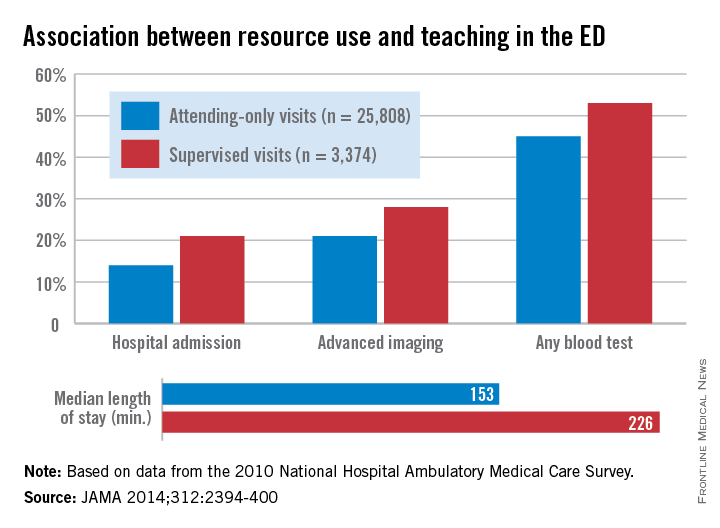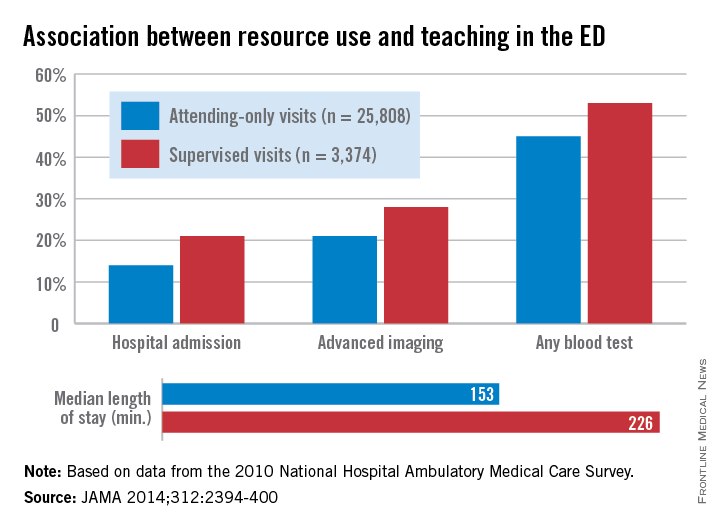User login
More resources are used in the emergency department when visits involve attending physicians supervising residents, according to a study published Dec. 9 in JAMA.
Compared with attending-only visits in the ED, teaching visits with residents and attendings were more likely to involve hospital admission, advanced imaging, any blood test, and a longer visit time, reported Dr. Stephen R. Pitts of Emory University, Atlanta, and his associates (JAMA 2014;312:2394-400 [doi:10.1001/jama.2014.16172]).
Data for 29,182 visits from the 2010 National Hospital Ambulatory Medical Care Survey’s ED subfile showed that 21% of teaching visits involved a hospital admission, compared with 14% of attending-only vists. Advanced imaging was used in 28% of supervised visits (21% for attending only), and any blood test was used in 53% of supervised visits vs. 45% for attending-only vists. Visits involving a resident also were longer (226 minutes), compared with attending-only visits (153 minutes), Dr. Pitts and his associates said.
“Supervised learning favors a more deliberate, reflective decision-making style than nonteaching clinical visits,” and this was shown by the “consistently higher use of several ED resources among supervised visits, even after adjustment for several other possible determinants,” they concluded.
Dr. Pitts received partial salary support for a time during the study through a contract with the U.S. Dept. of Health & Human Services. One of his associates is an emergency medicine resident and another is the director of an emergency medicine residency. No other conflicts were declared.

More resources are used in the emergency department when visits involve attending physicians supervising residents, according to a study published Dec. 9 in JAMA.
Compared with attending-only visits in the ED, teaching visits with residents and attendings were more likely to involve hospital admission, advanced imaging, any blood test, and a longer visit time, reported Dr. Stephen R. Pitts of Emory University, Atlanta, and his associates (JAMA 2014;312:2394-400 [doi:10.1001/jama.2014.16172]).
Data for 29,182 visits from the 2010 National Hospital Ambulatory Medical Care Survey’s ED subfile showed that 21% of teaching visits involved a hospital admission, compared with 14% of attending-only vists. Advanced imaging was used in 28% of supervised visits (21% for attending only), and any blood test was used in 53% of supervised visits vs. 45% for attending-only vists. Visits involving a resident also were longer (226 minutes), compared with attending-only visits (153 minutes), Dr. Pitts and his associates said.
“Supervised learning favors a more deliberate, reflective decision-making style than nonteaching clinical visits,” and this was shown by the “consistently higher use of several ED resources among supervised visits, even after adjustment for several other possible determinants,” they concluded.
Dr. Pitts received partial salary support for a time during the study through a contract with the U.S. Dept. of Health & Human Services. One of his associates is an emergency medicine resident and another is the director of an emergency medicine residency. No other conflicts were declared.

More resources are used in the emergency department when visits involve attending physicians supervising residents, according to a study published Dec. 9 in JAMA.
Compared with attending-only visits in the ED, teaching visits with residents and attendings were more likely to involve hospital admission, advanced imaging, any blood test, and a longer visit time, reported Dr. Stephen R. Pitts of Emory University, Atlanta, and his associates (JAMA 2014;312:2394-400 [doi:10.1001/jama.2014.16172]).
Data for 29,182 visits from the 2010 National Hospital Ambulatory Medical Care Survey’s ED subfile showed that 21% of teaching visits involved a hospital admission, compared with 14% of attending-only vists. Advanced imaging was used in 28% of supervised visits (21% for attending only), and any blood test was used in 53% of supervised visits vs. 45% for attending-only vists. Visits involving a resident also were longer (226 minutes), compared with attending-only visits (153 minutes), Dr. Pitts and his associates said.
“Supervised learning favors a more deliberate, reflective decision-making style than nonteaching clinical visits,” and this was shown by the “consistently higher use of several ED resources among supervised visits, even after adjustment for several other possible determinants,” they concluded.
Dr. Pitts received partial salary support for a time during the study through a contract with the U.S. Dept. of Health & Human Services. One of his associates is an emergency medicine resident and another is the director of an emergency medicine residency. No other conflicts were declared.

FROM JAMA
